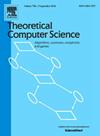Channel allocation revisited through 1-extendability of graphs
IF 1
4区 计算机科学
Q3 COMPUTER SCIENCE, THEORY & METHODS
引用次数: 0
Abstract
We revisit the classical problem of channel allocation for Wi-Fi access points (AP). Using mechanisms such as the CSMA/CA protocol, Wi-Fi access points which are in conflict within a same channel are still able to communicate to terminals. In graph theoretical terms, it means that it is not mandatory for the channel allocation to correspond to a proper coloring of the conflict graph. However, recent studies suggest that the structure–rather than the number–of conflicts plays a crucial role in the performance of each AP. More precisely, the graph induced by each channel must satisfy the so-called 1-extendability property, which requires each vertex to be contained in an independent set of maximum cardinality. In this paper we introduce the 1-extendable chromatic number, which is the minimum size of a partition of the vertex set of a graph such that each part induces a 1-extendable graph. We study this parameter and the related optimization problem through different perspectives: algorithms and complexity, structure, and extremal properties. We first show how to compute this number using modular decompositions of graphs, and analyze the running time with respect to the modular width of the input graph. We also focus on the special case of cographs, and prove that the 1-extendable chromatic number can be computed in quasi-polynomial time in this class. Concerning extremal results, we show that the 1-extendable chromatic number of a graph with n vertices is at most , whereas the classical chromatic number can be as large as n. We are also able to construct graphs whose 1-extendable chromatic number is at least logarithmic in the number of vertices.
通过图的1-可扩展性重新审视通道分配
我们重新审视了Wi-Fi接入点(AP)信道分配的经典问题。使用诸如CSMA/CA协议之类的机制,在同一信道内发生冲突的Wi-Fi接入点仍然能够与终端通信。在图理论术语中,这意味着通道分配与冲突图的适当着色相对应并不是强制性的。然而,最近的研究表明,冲突的结构而不是数量对每个AP的性能起着至关重要的作用。更准确地说,每个通道诱导的图必须满足所谓的1-可扩展性,这要求每个顶点都包含在一个独立的最大基数集中。本文引入了1可拓色数,它是图的顶点集的一个划分的最小尺寸,使得每个部分都能得到一个1可拓图。我们从不同的角度研究这个参数和相关的优化问题:算法和复杂性,结构,和极值性质。我们首先展示如何使用图的模块化分解来计算这个数字,并分析与输入图的模块化宽度相关的运行时间。我们还讨论了图的特殊情况,并证明了在拟多项式时间内可以计算1可拓色数。关于极值结果,我们证明了n顶点图的1可拓色数最多为2n,而经典色数可以大到n。我们还能够构造其1可拓色数在顶点数上至少为对数的图。
本文章由计算机程序翻译,如有差异,请以英文原文为准。
求助全文
约1分钟内获得全文
求助全文
来源期刊

Theoretical Computer Science
工程技术-计算机:理论方法
CiteScore
2.60
自引率
18.20%
发文量
471
审稿时长
12.6 months
期刊介绍:
Theoretical Computer Science is mathematical and abstract in spirit, but it derives its motivation from practical and everyday computation. Its aim is to understand the nature of computation and, as a consequence of this understanding, provide more efficient methodologies. All papers introducing or studying mathematical, logic and formal concepts and methods are welcome, provided that their motivation is clearly drawn from the field of computing.
 求助内容:
求助内容: 应助结果提醒方式:
应助结果提醒方式:


